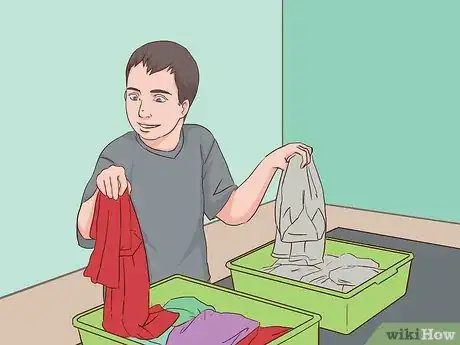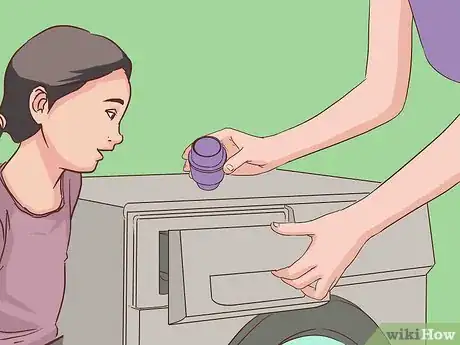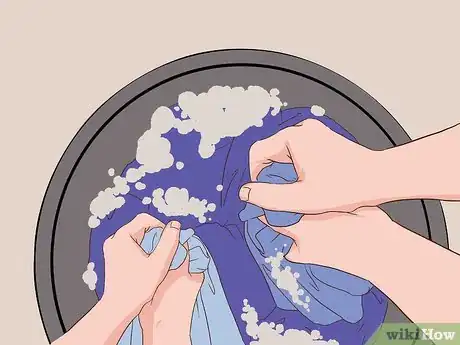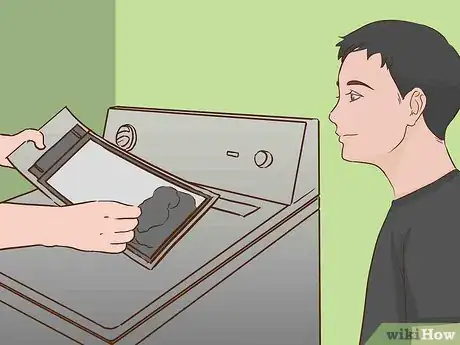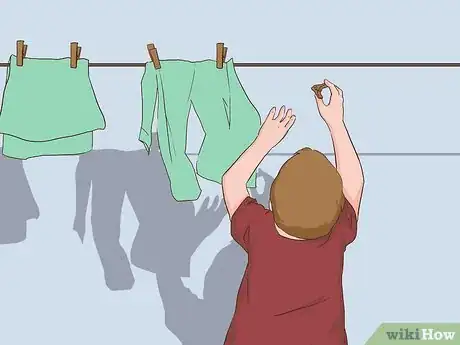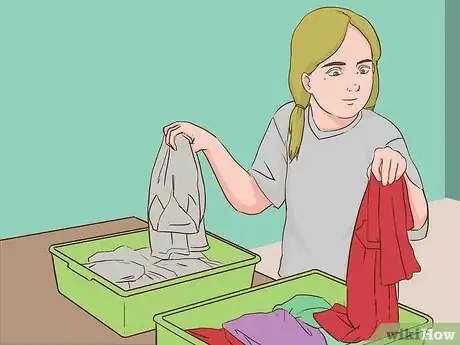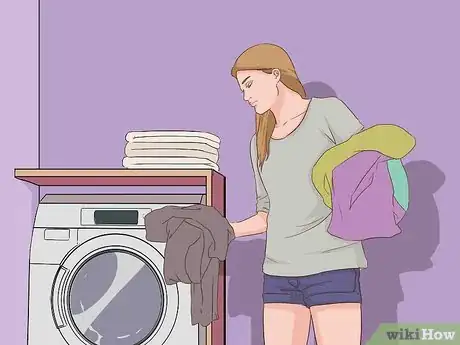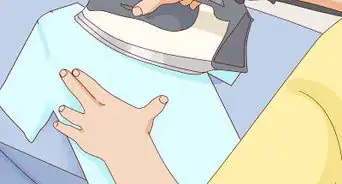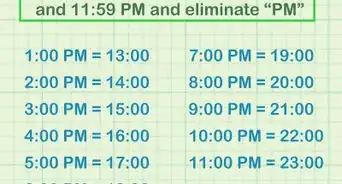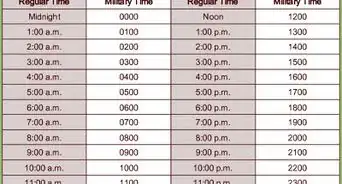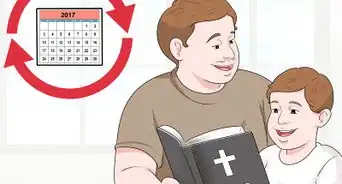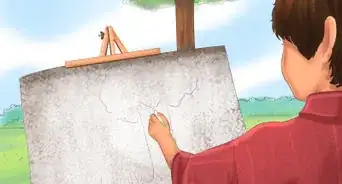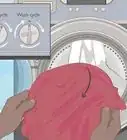This article was co-authored by Wits End Parenting. Wits End Parenting is a parent-coaching practice based in Berkeley, California specializing in strong-willed, “spirited” children with impulsivity, emotional volatility, difficulty “listening,” defiance, and aggression. Wits End Parenting's counselors incorporate positive discipline that is tailored to each child’s temperament while also providing long-term results, freeing parents from the need to continually re-invent their discipline strategies.
There are 8 references cited in this article, which can be found at the bottom of the page.
This article has been viewed 200,809 times.
Parents have a tendency to do everything for their kids. You know you want to have one less chore yourself, so go ahead and start shaping them into responsible adults now by teaching them how to do laundry. Walk them step by step through loading and setting the washer and dryer. Get them involved any way possible when they’re young and before you know it, they’ll be able to do it for themselves.
Steps
Teaching Children to Wash Clothing
-
1Teach them how to sort dirty laundry. Here’s where sortable bins come into play. A set of three or more bins gives children a place to separate whites, darks, jeans, and other articles you don’t want to mix. This can also be done in the laundry area, but bins simplify the task for younger children. As you teach them to sort, you can begin explaining why you need to separate the clothing.[1]
- At first, small children won’t understand why you separate the clothing. Stay patient with them. Explain it as many times as needed as they grow.
- Teach them to care for specialty clothing, too. For example, you may not want to wash formal clothing every week. Lycra needs a cold wash and should be done separately.
- Sorting is a good time to teach them additional steps, such as zipping up zippers, clearing out pockets, and reading labels.
-
2Help them load the washing machine. Let the kids throw in the clothing you plan on washing. Teach them the proper load size for your machine. You wouldn’t want to have them stuff in so much clothing that the washer overflows.[2]
- The proper load size is three-fourths full for a heavy load.
Advertisement -
3Show them how to add detergent. Before you let them press buttons, remind them to check the detergent level. Show them where to find the detergent tray and how much to add to it. Younger children will have a hard time pouring detergent themselves, so detergent pods are a great alternative.[3]
- Be aware that detergent pods such as Tide PODS can be dangerous. Some kids have swallowed the pods, thinking they are food. Teach your kids the pods aren’t to be eaten and store the pods in a safe spot up high when not in use.
- Similarly, you should supervise your children while they're handling chemicals, such as detergent.
-
4Teach them how to operate the washer. At last, it is time to explain the machine’s functions. Washing machines can be complex, and most adults only use a few functions on a regular basis. Start with a normal wash cycle and work your way up to the uncommon functions. Select one load type, such as dark clothing, and show the children which buttons they need to press to wash it. Explain the buttons to them as you go along. Don’t overload them by explaining multiple processes at once.[4]
- Label the buttons with permanent black marker or stickers. That way, children will have a quick reminder of what the buttons do.
- If you are worried, you can let them practice with less valuable clothing. Stay with them until you feel confident they understand what they’re doing, but don’t discourage them. Calmly explain any mistakes they make.
- With gradual teaching, children will be capable of handling the machine around age eight.
-
5Show children how to wash clothing by hand. Some clothing, such as Lycra items, do better in the sink, but ordinary clothing can also be hand-washed. Read the clothing labels with the child for directions. Help them put a small amount of water in the sink and mix it with the proper amount of detergent. Show them how to swirl the clothing around in the soapy water without scrubbing or twisting. They’ll never be lost without a washing machine![5]
Showing Children How to Dry Clothing
-
1Have them move the clothing to the dryer. Let kids move wet clothing themselves. This is a step that any child can do. Since young children can participate, you can make laundry fun to do together as a family. It can even be a good idea to start children on dryer duty before teaching them the more complicated wash cycle.[6]
-
2Show them the lint catcher. Pull up the lint catcher. Remember that a clean lint catcher helps the dryer work better. You may explain this to kids. Don’t forget to tell them to clean off the lint and replace the catcher before each cycle. Remind them to do this until they remember it for themselves.[7]
-
3Let them add the dryer sheet. If you use dryer sheets, have them throw one in before the cycle begins. Young children can do this too. Fabric softener may be used instead, but this can be a bit challenging for younger kids to handle on their own.
- Dryer sheets and fabric softener soften clothes, add a pleasant scent, and reduce static. Using them is not mandatory, however.
-
4Teach them how to operate the dryer. Start off with a normal drying cycle. Explain to children what the buttons do and which ones they need to press. Work your way up to more uncommon options like permanent press or low heat cycles. Don’t give them too much information at once.[8]
- Like with the washing machine, label the dryer buttons with permanent black marker or stickers. It may prevent you from a costly repair bill for a broken knob.
-
5Show them how to dry clothing by hand. Read the drying labels together. Show the child how to squeeze out excess water without wringing. Delicate clothing does best when rolled up in a towel and gently squeezed. Otherwise, hang up clothing you wish to air dry.[9]
- An accordion-style folding rack is a great tool for younger children who aren’t tall enough to reach a clothesline.
Helping Children Fold and Store Clothing
-
1Have them sort out the clothing. Once the clothing is out of the dryer, it needs to be sorted. At first, help younger kids do this. Teach them what shirts go together, what pants go together, and so on. This can be done in their room on the bed. Loads with clothing from many family members may also be sorted in the laundry room with stackable plastic bins.[10]
- All family members can help with this part. It’s usually the most tedious and labor-intensive one. Do it together and it’ll be more bearable for everyone.
-
2Teach them how to fold clothing. Early on, folding will be difficult. Children ages three and four can start with folding socks and towels. Around age five, they can put away their own clothes but won’t have a grasp on proper folding technique. That’s okay. Teach them at their own pace. As long as they make the effort, you’re teaching them in the long run.
-
3Help them store their clothing. The final step is to get the clothing back where it belongs instead of on the floor. For younger children, first show them where you want their clothing to go. Do matching socks go in the top drawer? What hangs in the closet? Try labeling the drawers with stickers. Soon enough they’ll be able to put everything away on their own!
- Older children may have a sense of how to organize the clothes for themselves. Still, they may still appreciate hearing suggestions on how to do this better.
Encouraging Their Participation
-
1Make the laundry area child-friendly. Adjust the laundry process to make it easier for children. Get a small step stool so that younger children can see what you’re doing and reach the top of the machines. Purchase a set of small, plastic, stackable laundry bins. Kids can use these to sort clothing in their room and carry the bins to the laundry room without difficulty.[11]
- Keeping the laundry area organized is important. Store laundry cleaners up high so young children can’t reach them while unsupervised. Clear off shelves so heavy objects won’t fall on heads. Keep clutter off the ground so no one trips. It’ll keep kids safe.
- Create an instructional chart to show your child the steps for doing laundry. A visual chart works well for younger children.
-
2Have young children participate with safe tasks. It’s best to start young. Get children involved early when they’re curious and will find fun in doing laundry with you. Before age two, take them with you into the laundry room. After that, start them out with simple tasks like picking up dirty clothing and moving wet clothing to the dryer. You’ll notice that doing laundry becomes a habit for them.[12]
- Teach children under two years old to put dirty laundry in a hamper. At age three, encourage them to fold and store small items like socks. Patiently increase responsibility a little every year. Around age eight, they’ll be capable of handling the machines.[13]
- The laundry responsibilities you offer a child depend on age and trust. Some children develop faster than others.
- Watching an older sibling do the laundry can also encourage younger children.
-
3Make laundry fun for older kids. Kids near the end of their preteen years and beginning of their teenage years require different motivation to start. Make participation a requirement, but don’t badger them. Instead, say something like, “You’ll get to control these fancy appliances.” Many kids will enjoy the control they have when caring for themselves.
- Keep laundry fun and lighthearted. Working as a family and laughing together helps take the nuisance out of the work.
- It’s useful to break down the parts for children. Separate washing, drying, and putting away clothes. Consider taking breaks between parts or dividing up the chore. It’ll make doing laundry feel a lot more manageable.
- For older children, include laundry on their chores list. To motivate them, you might attach a rewards system for completing their chores or for doing a certain number of loads.[14]
-
4Encourage teenagers to be more independent. Stubborn teenagers require more persuasion. Sit down and talk with them. Explain to them in a calm, non-confrontational manner why you want them to do their laundry. Tell them, “I will show you how to be more independent” or “I need you to take this household responsibility for me.” If you’ve never shown them how to use the machines, take them into the laundry room and explain the process to them.
- Don’t get upset over mistakes at first. It’s better to forgive and give them confidence.
- If they don’t care about taking over their share of the laundry, then you may have to try refusing to do it for them. Tell them calmly that you can’t do it for them forever, and that no one else in your home will do it if they don’t.
Community Q&A
-
QuestionWhy don't kids like doing laundry?
 Community AnswerIt may be boring. If you turn it into a game or a competition, they might enjoy it more.
Community AnswerIt may be boring. If you turn it into a game or a competition, they might enjoy it more.
Warnings
- No matter how well you teach your children, anticipate that accidents may happen. Expect sweaters to become doll-sized or white shirts to turn pink. It can be best to handle delicates, sentimental items, or dry-clean only items on your own.⧼thumbs_response⧽
- Don't expect a young child to carry a full laundry basket up or down stairs. Even adults can struggle with this at times. It’s better for you to carry it than to overhear your child telling the doctor, "Mom made me carry this humongous load of laundry down the stairs!”⧼thumbs_response⧽
- Laundry detergent is a poisonous chemical, so don't let your child handle it without supervision.⧼thumbs_response⧽
Things You'll Need
- A few small plastic laundry baskets
- A stepping stool for young children
- Detergent or detergent pods for small children
- Permanent black marker or stickers labels for young children
- Storage spaces
- Dryer sheets or fabric softener
- Sink and towel or drying rack for washing by hand
References
- ↑ http://www.thesuburbanmom.com/2017/05/31/teach-your-kids-to-do-laundry/
- ↑ http://teachmama.com/teach-kids-laundry-become-wash-warriors/
- ↑ http://www.thesuburbanmom.com/2017/05/31/teach-your-kids-to-do-laundry/
- ↑ http://lifeasmom.com/kids-can-do-laundry/
- ↑ http://www.bhg.com/homekeeping/laundry-linens/clothes/how-to-wash-clothes-by-hand/
- ↑ http://www.notsoformulaic.com/teach-your-kids-laundry-simple/
- ↑ http://teachmama.com/teach-kids-laundry-become-wash-warriors/
- ↑ http://lifeasmom.com/kids-can-do-laundry/
- ↑ http://www.bhg.com/homekeeping/laundry-linens/clothes/how-to-wash-clothes-by-hand/
- ↑ http://www.thesuburbanmom.com/2017/05/31/teach-your-kids-to-do-laundry/
- ↑ http://overthebigmoon.com/how-to-teach-young-kids-laundry/
- ↑ http://teachmama.com/teach-kids-laundry-become-wash-warriors/
- ↑ http://www.mamaslaundrytalk.com/at-what-age-can-children-learn-to-do-laundry/
- ↑ Wits End Parenting. Parenting Specialists. Expert Interview. 5 March 2020.
